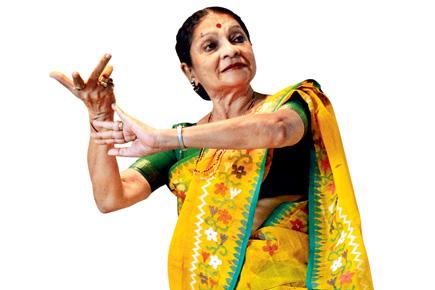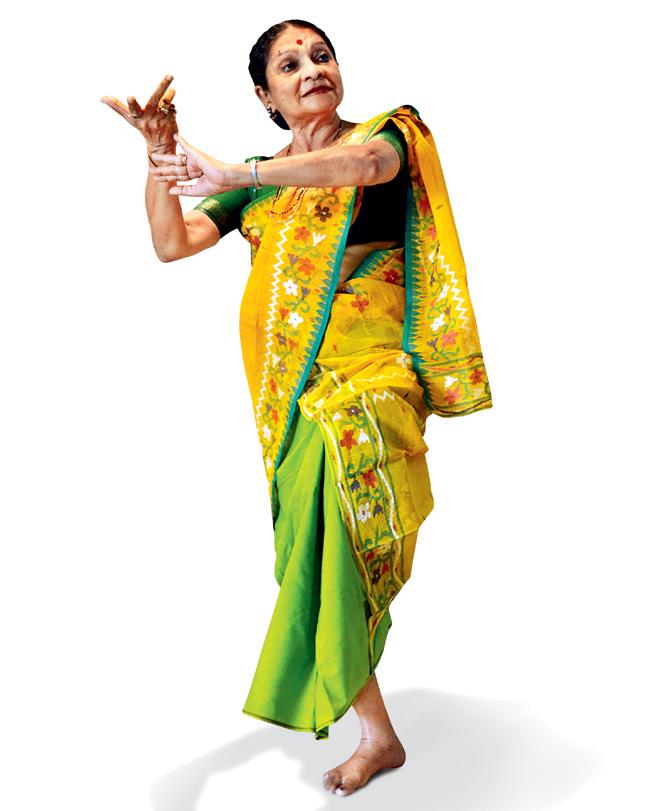Darshana Jhaveri and her sisters are credited for giving Manipuri Dance its modern structure. She tells Ananya Ghosh how four sisters hailing from South Mumbai went all the way to a Northeastern state and put their age-old temple dance on the global map

Padmashree Darshana Jhaveri
Leaving home and the luxuries of life for love is not unheard of. Naina, Ranajana, Suvarna and Darshana Jhaveri did just that. They left the cushy lives of their posh South Bombay home for their love—love for a dance practiced in the temples of a small state nestled far off in the Northeastern corner of the country.
Padmashree Darshana Jhaveri Pic/Datta Kumbhar
ADVERTISEMENT
And today, the Jhaveri Sisters, are hailed for bringing Manipuri dance from the temples of Manipur to the proscenium and making it accessible while staying true to the traditions. Although hailing from a conservative Gujarati society, their parents, especially their father Navnit Lal Jhaveri, a well-known businessman and art enthusiast, had a progressive outlook and the sister were exposed to different forms of dance and music from a very early age.
"It was the early '40s and Gandhiji was encouraging the youngsters to revive the cultural heritage of the country. Also, it was a time when Gurudev Tagore (Rabindranath Tagore) had brought respectability to various art forms and girls from aristocratic families were starting to show interest in dance and drama," says Jhaveri.
Their sprawling Marine Drive apartment was a hotspot for cultural gatherings, and artistes touring the city would often be invited to showcase their talents. One such artiste was guru Bipin Singh — the legendary Manipuri dancer. The year was 1943. And this will decide the future course of the lives of the sisters. "He was directing 'Jay Somnath' and my elder sister, Naina bagged the female lead in the play. And slowly, all four of us started taking dance lessons from him. "
In 1949, the sisters accompanied Singh to Manipur. "The devotion-charged atmosphere had a deep impact on us and by the end of the tour we decided to dedicate our lives to Manipuri dance." What followed were more trips to Manipur and extensive research on the various styles of the dance form. Different gurus taught them the nuances of the different styles before the sisters chose their specialisation—raasleela and sangkirtan — the two classical styles.
In 1956, the sisters performed in front of the three great gurus — Guru Amubi Singh, Guru Amudon Sharma and Guru Atomba Singh — and two years later they became the first non-Manipuris to perform at the Sri Govindji Temple. However, took them many more years and performances to get truly accepted by the Manipuri people.
"Manipur then was quite cut off from the rest of the country and it took us almost a week to reach there. While this helped them preserve their age-old traditions, they were averse to any new concept," says Jhaveri. The sisters were even criticised by the locals for 'commercialising ' their traditional dance.
Opposition came from within their own community as well. "The Gujarati community was a conservative one. Respected families hardly encouraged their daughters to learn dancing, let alone take it up as a profession. But we had a rock-solid support system behind us in the form of our parents," Jhaveri says.
Armed with their parents' blessing and their own determination, the girls went on to break new grounds. "In Manipur, one performance would go on for whole night. Modern audience wouldn't sit through that. So, to make the dance accessible, we made it concise and brought it within the two-hour frame. Staying strictly within the traditions, we picked up the root elements from the compositions and developed them to suit the proscenium format," she says.
The sisters, along with their guru, also put the dance form into a standardised structure by documenting its various elements. "There were no written documents or rules; it was all passed on from one generation to another through oral tradition of guru-shishya parampara. We started touring Manipur and collected and recorded songs, music, talas, and rhythm patterns of raasleela and sangkirtan from different gurus and traced each back to its classical tenet.
Today I have a rare collection of around 1800 tapes, painstakingly put together over a span of five decades," says the youngest of the Jhaveri Sisters. Simultaneously, the sisters were looking for acceptance from the world audience as well. Through them the temple dance of Manipur reached almost every corner of the globe.
However, today, back home, Jhaveri finds the scene bleak. "Children nowadays, especially in Mumbai, either want to learn Western dance or Bollywood numbers. Even the audiences are reluctant to spend on classical performances. Nobody really cares about classical forms—be it music or dance," she rues.
So, how about introducing fusion? we ask. And she is categorical. "We gave a scientific structure to the dance but we did it while staying true to the age-old traditions. I don't believe in the concept of watering down the content to suite public taste," her voice trails. As we wrap up we wonder about the future of classical dance forms like these. Outside, the sun is about to set and the streetlights are rescuing the Marine Drive from plunging into darkness, one patch at a time. Maybe it is a sign of hope.
Darshana Jhaveri will be part of Mumbai Local this Friday at Kitab Khana between 5.30pm and 6.30pm
 Subscribe today by clicking the link and stay updated with the latest news!" Click here!
Subscribe today by clicking the link and stay updated with the latest news!" Click here!






